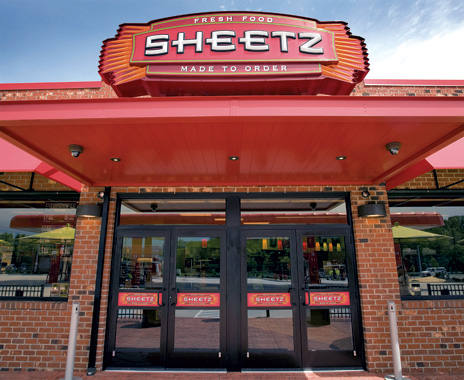Forget your grandfather. These aren’t even your father’s convenience stores.
There are menus touting spicy chorizo and smoked Gouda on ciabatta, baked tilapia, and arabica coffee. There’s signage broadcasting terms like artisanal, organic, and free range. And there’s plush interior seating and complimentary WiFi, with reclaimed wood and natural stone design features.
Once a world of smokes, Cokes, and salty snacks, a utilitarian environment to enter and exit but certainly not linger, convenience stores have morphed into something different, something almost unthinkable even a decade ago: a place for dining and a viable alternative to traditional quick-service restaurants and even their fast-casual brethren.
Food-forward convenience store chains like Sheetz, Wawa, and Cumberland Farms are leading the charge, embracing more compelling and fresh foodservice offerings that transcend expectations and leverage the convenience inherent in C-stores’ DNA.
“This is not a minor blip on the radar,” says Bonnie Riggs, restaurant industry analyst for The NPD Group’s foodservice division. “C-stores are here to stay as a competitor to quick-service restaurants.”
According to NPD, consumers made nearly 4.9 billion visits to C-stores for prepared meals and snacks in the year ending May 2016, representing a 15 percent increase over 2010. More notably, perhaps, C-stores have notched double-digit traffic growth during the lunch and dinner dayparts—the traditional wheelhouse of quick-service restaurants.
The C-store surge
For decades, convenience stores existed as little more than bit players in the foodservice game. While stopping to fill up the car’s gas tank or grab a lottery ticket, a customer might also be corralled by the C-store to purchase a coffee, frozen yogurt, or pastry.
By and large, C-stores seemed content with this reality, acknowledging that grabbing a full meal
inside their doors—and certainly any thought of dining inside—seemed an odd, ill-fitting choice.
Slowly, however, C-stores pushed into traditional daypart meals to capture added foodservice traffic. At first, it was largely as a partner to quick serves seeking nontraditional unit growth. C-stores carved out room for a quick-service eatery and captured steady income sans the operational fuss. Pilot Flying J Travel Centers, for example, feature more than 400 quick-service restaurants, including brands like Arby’s, Cinnabon, McDonald’s, Subway, and Moe’s Southwest Grill.
Though a viable business model for many C-stores, the nontraditional, cobranded units also highlighted a significant missed opportunity.
“I think a lot of C-stores started to ask themselves what they really got by putting another brand in their store,” Riggs says.
Around the recession, C-stores’ historical ignorance to the fresh-foods game began to wane. As consumers favored more on-the-go options and traditional foodservice channel lines blurred, convenience stores looked to leverage their marketplace positioning in new, more aggressive ways.
“If there’s trust and authority there, then a lot of convenience stores wondered why they shouldn’t try to grab the entire basket,” says Chelsea Gross, an analyst with Planet Retail/RetailNet Group.
Many C-store chains—a number of which had been dabbling in larger superstore concepts—became opportunistic enterprises, Gross says. They accelerated their rollout of enhanced foodservice offerings, ditched their NASCAR-like interiors, and embraced the possibilities.
In 2012, Fortune acknowledged that it would be hard to imagine gas stations becoming “the next Whole Foods,” but noted how convenience store powerbrokers were making a play to do just that “by offering fresh baked goods, high-quality coffee, and even a wide selection of fresh produce.”
In recent years, C-stores’ efforts to capture share of stomach has only intensified, particularly as fuel-peddling shops have watched their profit margins squeezed on the gas side. In this new foodservice era, C-stores—both marquee chains as well as independents—are working to keep pace not only with one another, but also with grocery stores and fast-casual outlets, thoughtfully and vigorously challenging that notion that they belong on the fresh foods sidelines.
Food and environment
Among convenience stores, Pennsylvania-based Sheetz is a pioneer in the fresh-made foods space, tracing its made-to-order program back some 30 years.
About 10 years ago, however, Sheetz, which claims more than 500 units across six mid-Atlantic states, dove deeper into the pool with healthier alternatives like fresh fruits, yogurts, and wraps, as well as a commissary. Today, all Sheetz stores sport barista stations and full-service kitchens churning out food options like fresh-made burritos, bowls, and salads.
“In the communities we are in, there are a lot of gaps for this, and we think of ourselves as the one-stop shop,” says Sheetz prepared foods manager Courtney Williams.
And Sheetz is far from alone. While C-stores have long trumpeted their convenience, promising customers a quick stop for any number of needs ranging from a gallon of milk and bread to transmission fluid and motor oil, fresh foods have also found a home.
7-Eleven, one of the nation’s foremost C-stores with some 8,000 U.S.-based locations, features an expanded selection of organic and healthy snacks in many of its stores. Gross points to one 7-Eleven inside a downtown Chicago tower that features standalone displays with dried fruit and granola bars urging guests to “Treat Yourself,” as well as a salad vending machine called the Farmer’s Fridge.
In 2013, Pilot Flying J introduced PJ Fresh Marketplace, an effort to serve travelers hungry for home-style food options crafted from fresh ingredients. PJ Fresh Marketplace delivers an expanded variety of meals for dine-in guests and on-the-go food options, many of which are prepared daily in-store, says Pilot Flying J vice president of marketing and merchandising Laura Palenkas.The PJ Fresh Marketplace menu includes PJ Fresh Pizza, a pizzeria-quality, never-frozen offering of hand-tossed dough, real Mozzarella cheese, and fresh toppings, as well as exclusive coffee blends sourced from regions around the world. Earlier this year, meanwhile, Pilot Flying J debuted PJ Fresh Breakfast Sandwiches with ingredients like scrambled eggs and Angus steak.
“We aim to make the in-store and on-the-go dining experience as enjoyable as possible, ensuring that [guests] have a meal, beverage, or snack option that meets their preference,” Palenkas says.
Over the last decade, Steven Turner, director of food programs and offers at RaceTrac, an enterprise with more than 600 stores across the southern U.S., says consumers have become more vocal about their interest in quality, fresh food options, particularly when traveling. RaceTrac has responded with a litany of offerings, ranging from whole fruits and grab-and-go salads delivered fresh every day to its Swirl World frozen dessert bar, which includes a variety of yogurt and ice cream flavors alongside more than three-dozen toppings.
In addition, Atlanta-based RaceTrac is now testing a Made-to-Order program featuring customizable items, such as breakfast sandwiches, deli sandwiches, and specialty espresso drinks that can be ordered at in-store kiosks. “Our mission at RaceTrac is to make people’s lives simpler and more enjoyable and we deliver on this mission by delivering fresh, high-quality, delicious eats in an environment that can facilitate grab-and-go needs or a break from a busy day,” Turner says.
With momentum on the food side accelerating, many C-store chains are now tackling the store environment to complete the picture.
A number of C-store brands have debuted more sophisticated dining spaces on par with fast-casual eateries. Chains have integrated community tables and upholstered benches, charging ports for digital devices, and enhanced lighting.
“You’ll find elements in some of these stores that you’d find at a Starbucks, and that’s not by accident,” says Lynn Rosenbaum of Ohio-based Chute Gerdeman, a design and brand strategy partner for retail brands. “The convenience stores know they need to match this world.”
And in an effort to distance their interiors from the gas pumps outside—a primary C-store traffic driver—convenience stores are presenting a more professional setting with modern fixtures, uniformed employees, and strategically positioned seating that gazes upon landscaping or the roadway rather than the gas pumps.
Rosenbaum predicts convenience stores will increasingly become more of a “third place”—terminology once floated by the likes of Panera and Starbucks but now increasingly uttered by C-store execs.
“With the food and environment improving, convenience stores can become more destination than something en route,” Rosenbaum says.
An accelerating push
Reasserting a new experience and reshaping long-held traditions, C-stores are pushing once unforeseen ideas like health and wellness while simultaneously leveraging thousands of points of distribution and other inherent factors—namely, convenience and a rich value proposition—to compete at a higher level.
Indeed, convenience is a key point of differentiation C-stores are more than happy to promote. RaceTrac’s Turner says his units have a variety of new, fresh, and high-quality foodservice offerings to choose from, as well as thousands of convenience-store products like snacks, fountain drinks, alcoholic beverages, and more to attract visits.
“The choice is in our guests’ hands when they come to RaceTrac … and we have a little something to cater to everyone,” Turner says.
C-stores are also championing advantages in price, a historically key driver of quick-service visits. The NPD Group reports that the average ticket for prepared foods and snacks at C-stores is $3.67, a full $2 less than traditional quick-service restaurants. Many C-stores also claim widely used loyalty programs that further propel the value proposition, Riggs says.
Earnestly determined to evolve and capture market share in the foodservice space, C-stores show no signs of relenting.
RaceTrac, for instance, recently redesigned the packaging of its freshly delivered food items to make the food more visible, while the chain will also be updating its store portfolio over the next two years with expanded indoor and outdoor seating. There will also be complimentary WiFi to deliver a more comfortable and consistent brand experience.
According to a 2014 Hartman Group report titled “Convenience Stores and the ‘Fresh’ Opportunity,” C-stores are also wooing two key groups expected to spur consumer spending: women and Millennials, a segment the Hartman Group says “treat[s] convenience stores as just another food channel.”
C-stores are promoting family-sized food selections, new products featuring high-quality ingredients, and “in-and-out” environments. And to appeal more to women and families, they’re moving toward gender-neutral marketing that eliminates the life-sized cutouts of cheerleaders and bikini models.
Such improvements, Sheetz’s Williams says, stand to drive momentum across the C-store landscape.
“As C-stores improve their foodservice offerings, that’s good for Sheetz and good for other C-stores, as well, because we’ll all become that much more a part of the consumers’ competitive set,” she says.
The quick-service response
As consumer eating habits continue to evolve, the Hartman Group opines that “convenience stores have significant opportunities to capitalize on food and beverage occasions that are historic for them—but for which other retail channels, including restaurants, are competing.”
Make no mistake: This is an intensifying battle, and C-stores have fired their shots. The question now is: How do quick serves respond amid the heightened competition and increased channel blurring?
Gross says it’s imperative quick-service restaurants focus on low-cost operations, tailored customer service, and sharpened price points that consumers can easily understand. Even more, she says, quick serves should look to capitalize on the digital fulfillment advantages they have over other categories, including convenience stores, to drive performance.
“You can order from Domino’s with an emoji,” Gross says. “Quick serves have a clear advantage today with digital, and now it’s up to them to accelerate that lead.”
Rosenbaum, meanwhile, wonders if quick serves might not counter convenience stores’ foodservice gains by extending product lines and grab-and-go selections, even offering fresh produce and artisan breads for customers.
“How can quick serves flip the script and extend foodservice into some of the places where convenience stores are making gains?” Rosenbaum asks.
However quick serves choose to respond, Riggs says, a strategic, thought-out response to C-stores’ increasing gains is necessary, a process that must begin with operators acknowleding C-stores as direct competition much as they do the nearby sandwich shop, pizza parlor, and hamburger joint.
“Quick serves will have to develop a strategy to defend their turf and be much more aware of what convenience stores are doing,” Riggs says. “Otherwise, they could look up and wonder what happened.”







